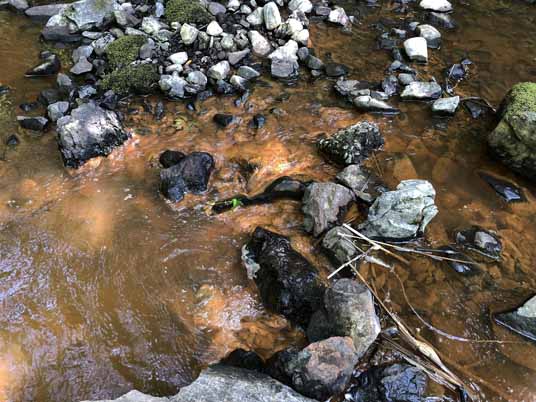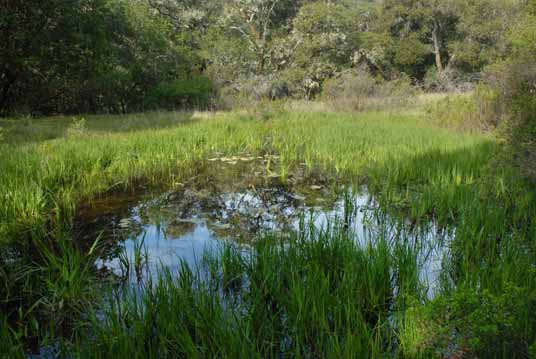by Sandy Guldman

“Marin Water proposes to create a connection between Phoenix Lake and Bon Tempe Reservoir to improve operational efficiency and allow for more frequent use of Phoenix Lake water without the existing required intensive system modifications.” This statement is found early in the environmental review document prepared for the project, the Initial Study/Mitigated Negative Declaration for the Phoenix Lake—Bon Tempe Connection Project.
On its face, this seems like a simple project to move water from one reservoir to another by building a new pipeline. This would avoid the need to repeatedly modify the existing water infrastructure to alternate between conveying treated and raw water directly to and from the Bon Tempe Treatment Plant. However, we are concerned about damaging effects on aquatic life in Ross Creek that the project will have unless measures are taken to avoid them.
However, the environmental document ignores some crucial aspects of the project: It would move water from the Corte Madera Creek Watershed into the Lagunitas Creek Watershed, with potential impacts on water quality, riparian habitat, and the steelhead population in Phoenix Lake and in Ross and Corte Madera creeks. It does not mention the significant existing impacts of the Phoenix Lake Dam on those same resources. It does not acknowledge the persistent presence of steelhead/rainbow trout (Oncorhynchus mykiss), a federally listed species, in Ross Creek. It ignores the need to consult with the SWRCB, which regulates inter-basin water transfers, and with NOAA Fisheries, with authority over O. mykiss.
Presence of Fish in Ross Creek
There is ample evidence that Ross Creek supports O. mykiss. A crew led by Eric Ettlinger electro-fished five pools in Ross Creek between the dam and the parking lot at Natalie Coffin Greene Park on August 3–4, 2005. They found 185 O. mykiss, 62% of all the fish captured.
Over the years before and after, numerous O. mykiss have been seen by people visiting Ross Creek. Although many of the O. mykiss may not practice anadromy, that could easily change when fish barriers downstream of Phoenix Lake are removed. This is especially true when a major project will be implemented to remove barriers to fish passage caused by the Ross fish ladder and the concrete channel in Ross and Kentfield. It is scheduled for fall 2025.
Temperature and Dissolved Oxygen
Phoenix Lake typically stratifies in the spring, meaning that water in the lake is divided into stable layers, with warm water on the top and increasingly cool water as depth increases. The stratification ceases when cooler weather and winter wind and rain lower the surface water temperature and the layers mix. Temperature and dissolved oxygen (DO) data collected in Ross Creek since 2008 show that when Phoenix Lake is discharging over the spillway in the spring after the lake has stratified, the water entering Ross Creek is well oxygenated, but too warm for O. mykiss. When the water level drops and discharge over the spillway stops, water in the upper portions of Ross Creek comes mostly from leakage from the low-level release valve or from groundwater seeping through the base of the dam. Its characteristics are very different: it is much cooler and has virtually no DO.
Iron and Manganese Levels

A serious water quality problem in Ross Creek is a direct result of the low DO and high iron and manganese content in water at the bottom of Phoenix Lake. A report prepared by Friends in 2011 presents the results of water tests that show harmful levels of iron and manganese in the water leaking through the low-level release valve into Ross Creek. The excess iron is obvious in orange deposits on anything the water contacts near the valve. Black deposits on the rocks further downstream of the dam are likely deposits of oxidized manganese. Independently of the proposed project, Marin Water should implement measures to aerate the water column in Phoenix Lake so that water entering Ross Creek has better water quality.
Hydrology
The analysis of Ross Creek hydrology in the environmental document was prepared to assess whether the proposed diversions would “significantly delay or reduce flows at times when steelhead may be using fall pulse flows in Ross Creek as a cue to trigger upstream migration and spawning activity.” The study does not recognize that O. mykiss typically spawn in January through March, not the fall. It also fails to account for the hydrologic impact on rearing and emigration. The project’s impacts on all life stages of O. mykiss should be evaluated. Protecting only part of a life cycle is not enough.
Board Policies
Finally, the proposed connection does not comply with Marin Water’s stated policies. Board Policy No. 7, adopted September 10, 2010, PART 2−Biological Diversity, begins with this goal:
Protecting the integrity of the watershed is best achieved through maintaining natural conditions on watershed lands consistent with District policies and federal and state laws. The District is committed to restoring and sustaining native biological diversity on District lands, in particular the variety of living organisms, the genetic differences among them, and the natural communities and ecosystems providing their habitat.
Applicable policies in PART 2 include:
A. Species and Habitats – The District will protect and restore species richness and complexity of habitats on District lands, and seek to preserve or restore natural habitats to the fullest extent possible.
B. Rare Species – The District will identify and promote conservation of all special status plant and animal species especially those listed under federal and state Endangered Species Acts.
C. Adverse Impacts – The District will minimize adverse impacts to spatial and temporal patterns of native species for reproduction, feeding, migration, and dispersal….
J. Streams − The District will take actions to protect native fishery resources, in streams within the District’s sphere of influence, consistent with California public trust doctrine and Fish and Game Code. The District will be an active partner in stream protection and enhancement efforts that other agencies and groups are pursuing in streams within the District’s sphere of influence. The District’s sphere of influence includes those streams that are directly affected by the District’s land or water management activities.
Friends has requested that the Initial Study/Mitigated Negative Declaration be revised to more accurately reflect the presence of fishery resources in Ross Creek and the impacts of this project and Phoenix Lake Dam have and would continue to have on those resources and to acknowledge the regulatory requirements. The District has an opportunity to improve conditions for aquatic life in the creek fed by Phoenix Lake, consistent with its policies, and should not sidestep this opportunity and responsibility.
We urge concerned citizens to let Marin Water know that a more thorough analysis is called for. In addition, it should identify the mitigation measures necessary to improve habitat in Ross Creek
All of the reports mentioned in this condensed article are available. If you would like more details, email us at info@friendsofcortemaderacreek.org




